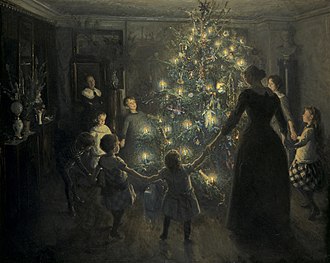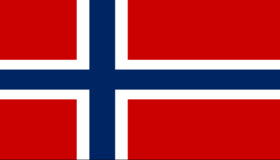Christmas in Emerstari
| Christmas in Emerstari | |
|---|---|
 Rundt der Kristustra by Klaus Johann Erikssen | |
| Official name | Kristusdeg |
| Also called | Kristustid |
| Observed by | Christians |
| Liturgical Color | White |
| Celebrations | Nicholas, Ambrose, Lucia, John of the Cross, Daniel, Adam and Eve, Katherina von Bora, Thomas, Christmas Eve, Twelve Days of Christmas, Christmas, Stephen, John, Holy Innocents, David, Feast of the Holy Name of Jesus, Epiphany |
| Begins | 6 December |
| Ends | 6 January |
| Date | 25 December |
| Frequency | annual |
| This article is part of on the |
| Culture of Emerstari |
|---|
 |
| Society |
| Traditions and Art |
| National symbolry |
| Other |
Kristustid, the Emerstarian Christmas, is celebrated throughout most of December starting with Saint Nicholas Day on 6 December. Christmas Eve, Kristusforredeg, the main event of Kristustid, is celebrated on the evening of 24 December, the evening before Christmas Day, Kristusdeg.
Jul was originally an ancient Emerstarian tradition that celebrated the Winter Equinox, but it was replaced by Kristustid during the Christianization of Emerstari. The traditions related to Kristusdeg have evolved through the centuries; still, numerous pagan traditions exist today. In the late 1600s, the tradition of a Christmas tree inside the home was introduced due to the 1691 Christmas tree of King Karl IV Lorens.
Traditions
Month of December
The Christmas celebration in Emerstari usually begins with Saint Nicholas Day, Sankta Nikolas Deg, in early December. However, Christmas decorations might be put up much earlier, often after All Saints Day (Emerstarian: Allta Sanktar Deg). Many schools start their Christmas vacation on 6 December as well, lasting through to 6 January. Many workplaces start the vacation later, by 20 December and last until 6 January.
Church visits
In Emerstari, there is a tradition to go to Church on the morning of 26 December. Although, sizeable church services happen on December 6, 13, 25, and January 6 as well. The services on 26 December, as previously said, are the most heavily visited services with around one-third of the population attending.
Christmas tree
Christmas trees in Emerstari first found popularity in Emerstari when in 1691, King Karl IV Lorens had a Christmas tree put into Rensulier Palace's Grand Hall. The first Emerstarian Christmas trees were generally decorated with live candles, fruits, and candy. On top of the tree was usually placed a Ljuskrone (English: Light Crown), but soon putting stars on top of the trees became popular as well. In the nineteenth century, commercial Christmas tree decorations became more readily available, most of which were imported from Canaria and Marseile. The day that people decorate Christmas trees today varies, but traditionally, they were decorated on 13 December, or Saint Lucia's Day.
Sankta Nikolas
In Emerstari, Santa Claus is known as Sankta Nikolas or Farfar Vinter (English: Grandfather Winter), and he is said to arrive on a sleigh drawn by reindeer with presents. He is assisted by elves known as Nikolaskalver (English: Nicholas's Elves). According to some traditions, Nikolaskalver dwell in barns, gardens, and other such places. To maintain the favor and protection of Sankta Nikolas and Nikolaskalver, children leave out milk and treats for them.
Food and drink
A Kristusdegbord (English: Christmas table) is a traditional three course dinner served on Christmas Eve. The first course typically may be a variety of fish, especially herring and salmon and eel, with potatoes or other vegetable. This is typically accompanied by snaps, brænnvin, or akvavit.
The second course often consists mainly of meats including a Christmas ham, sausage, various types of cheese, pickled cucumbers, and crisp breads. It is not uncommon for leverkram to be served alongside the breads.
The third course traditionally includes warm dishes like meatballs, sausages, pork ribs, and potato casserole with cream, onion, and sprats called Hanssens fristelse.
Other dishes that may be served include cabbage, beans, shrimp, and lutfisk. A fourth course, desserts, may be served; traditionally, this course would consist of kannelbrod (English: Cinnamon bread), appelkakke (English: Apple cake), ostkakke (English: Cheese cake), or risgrot (English: rice pudding).
Other Traditions
Emerstari has adopted and expanded the tradition of Advent calendars. It is common to have a Vinterkalender (English: Winter calendar) that mark all days from 1 December until 24 December. They often are made of cardboard and have treats for each day such as chocolate.
Above Emerstarian fireplaces are often hung stockings wherein Sankta Nikolas will place additional small presents for children such as money or candy.
Forrekristusdeg (English: Pre-Christmas Day) is the week before Christmas. In the Middle Ages, restrictions on hunting and fishing were lifted during this period. During the week between Christmas and New Year's Eve, Kristusdegskfrid (English: Christmas Peace), all hunting and fishing are prohibited.


